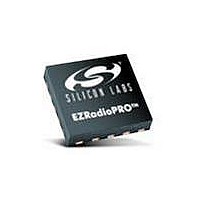4320-DKDB2 Silicon Laboratories Inc, 4320-DKDB2 Datasheet - Page 2

4320-DKDB2
Manufacturer Part Number
4320-DKDB2
Description
KIT DEV TEST EZRADIO SI4320 RX
Manufacturer
Silicon Laboratories Inc
Specifications of 4320-DKDB2
Accessory Type
Test Card, Receiver, 434MHz
Wireless Frequency
434 MHz
Interface Type
SPI
Modulation
FSK, OOK
For Use With/related Products
EZRadio®
Lead Free Status / RoHS Status
Lead free / RoHS Compliant
Lead Free Status / RoHS Status
Lead free / RoHS Compliant, Lead free / RoHS Compliant
DETAILED DESCRIPTION
General
The Si4320 FSK receiver is the counterpart of the Si4220 FSK
transmitter. It covers the unlicensed frequency bands at 315,
433, 868, and 915 MHz. The device facilitates compliance with
FCC and ETSI requirements.
The
demodulation, allowing the use of a minimal number of external
components in a typical application. The Si4320 consists of a
fully integrated multi-band PLL synthesizer, an LNA with
switchable gain, I/Q down converter mixers, baseband filters and
amplifiers, and an I/Q demodulator followed by a data filter.
PLL
The programmable PLL synthesizer determines the operating
frequency, while preserving accuracy based on the on-chip
crystal-controlled reference oscillator. The PLL’s high resolution
allows for the use of multiple channels in any of the bands.
The RF VCO in the PLL performs automatic calibration, which
requires only a few microseconds. Calibration always occurs
when the synthesizer begins. If temperature or supply voltage
changes significantly or operational band has changed, VCO
recalibration is recommended. Recalibration can be initiated at
any time by switching the synthesizer off and back on again.
LNA
The LNA has 250 Ohm input impedance, which works well with
the recommended antennas. (See Application Notes available
from www.silabs.com/integration.)
If the RF input of the chip is connected to 50 Ohm devices, an
external matching circuit is required to provide the correct
matching and to minimize the noise figure of the receiver.
The LNA gain (and linearity) can be selected (0, –6, –14, –20 dB
relative to the highest gain) according to RF signal strength. This
is useful in an environment with strong interferers.
Baseband Filters
The receiver bandwidth is selectable by programming the
bandwidth (BW) of the baseband filters. This allows setting up
the receiver according to the characteristics of the signal to be
received.
An appropriate bandwidth can be selected to accommodate
various FSK deviation, data rate, and crystal tolerance
requirements. The filter structure is a 7-th order Butterworth low-
pass with 40 dB suppression at 2*BW frequency. Offset
cancellation is accomplished by using a high-pass filter with a
cut-off frequency below 7 kHz. See Measurement Results section
for measured receiver selectivity curves.
receiver
employs
the
Zero-IF
approach
with
I/Q
Data Filtering and Clock Recovery
The output data filtering can be completed by an external
capacitor or by using digital filtering according to the final
application.
Analog operation: The filter is an RC type low-pass filter and a
Schmitt-trigger (St). The resistor (10k) and the St is integrated on
the chip. An (external) capacitor can be chosen according to the
actual bit-rate. In this mode the receiver can handle up to 256
kbps data rate.
Digital operation: The data filter is a digital realization of an
analog RC filter followed by a comparator with hysteresis. In this
mode there is a clock recovery circuit (CR), which can provide
synchronized clock to the data. With this clock the received data
can fill the RX Data FIFO. The CR has three operation modes:
fast, slow, and automatic. In slow mode, its noise immunity is
very high, but it has slower settling time and requires more
accurate data timing than in fast mode. In automatic mode the
CR automatically changes between fast and slow modes. The CR
starts in fast mode, then automatically switches to slow mode
after locking.
(Only the data filter and the clock recovery use the bit-rate clock.
Therefore, in analog mode, there is no need for setting the
correct bit-rate.)
Data Validity Blocks
RSSI
A digital RSSI output is provided to monitor the input signal level.
It goes high if the received signal strength exceeds a given
preprogrammed level. An analog RSSI signal is also available.
The RSSI settling time depends on the filter capacitor used.
Voltage on ARRSI pin vs. Input RF power
P1
P2
P3
P4
-100 dBm
-100 dBm
-65 dBm
-65 dBm
1300 mV
1000 mV
600 mV
300 mV
Si4320
2














